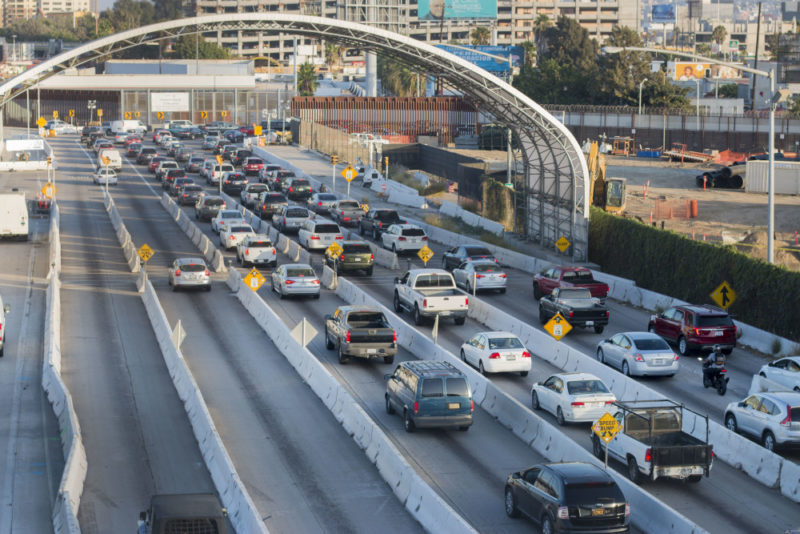The San Ysidro Port of Entry has been embroiled in controversy in recent weeks.
Two San Diego-based lawsuits — one over the ability to take photos at land-border crossingsand another alleging Customs and Border Protection officials are illegally turning away asylum-seekers — have gotten green lights from courts to move forward.
The conduct of officers working at ports of entry was also brought into question.
An investigation by The Center for Public Integrity laid out several instances — including some in San Diego — where officers conducted strip searches and body cavity probes on women and minors in search of drugs and other illicit contraband. Some women were handcuffed and transported to hospitals for pelvic exams and X-rays, and one was even sedated against her will. In all those cases, Border Patrol did not find drugs.
The U.S. attorney’s office in the Southern District of California recently indicted one CBP officer for strangling a traveler and another former Border Patrol agent admitted to creating false security alerts so an innocent man would be detained while going through ports of entry. That man had accused the agent’s brother-in-law of molesting their child, according to federal prosecutors in San Diego. The false alert resulted in the man being sent to secondary inspection and being detained for hours five times, even though he was a legal U.S. resident with no criminal background.
Ports of entry generally receive far less attention than the parts of the border between them. Border Patrol, the agency that guards those portions of land, is often at the center of the news and of political discussions about the border — whether it’s a border wall, staffing issues or additional funding.
But far more people — and illicit goods — travel between the United States and Mexico through official ports of entry, and all the news in the past couple of weeks reinforces why we should be paying more attention to them.
I reached out to Josiah Heyman, the director of the Center for Interamerican and Border Studies at the University of Texas at El Paso, who has been writing about ports of entry for more than a decade. He defines ports of entry as the legally designated place where people and vehicles, commercial goods and non-commercial visitors can enter the United States. It’s a place where people make themselves and their goods available for inspection by the U.S. government.
Ports of entry include both land crossings, like the ones in San Ysidro and Otay Mesa, international airports and sea ports, like the ones in Los Angeles and Long Beach, which form the largest port of entry in the United States.
Land ports of entry, said Heyman, far outdate the Border Patrol. Border Patrol was founded in 1924, but ports of entry date back to the 19th century, though under a different name. The San Ysidro Customs House, which is still on the port site today, dates back to 1933, but there has been a border inspections station there since the early 20th century, said CBP spokesman Nolan Stickles.
On a typical day, Border Patrol processes 691,549 travelers through land ports of entry nationwide, and apprehends roughly 851 people between ports of entry.
“The priority of U.S. border policy should be ports of entry,” Heyman said. But even though ports deal with more people and goods, symbolic politics get in the way.
As the Washington Post reported earlier this year, CBP faces such bad officer shortages that many officers at ports being asked to spot illicit goods and people while working back-to-back eight-hour shifts. At the same time, the administration is trying to spend billions on a wall between the ports of entry when border apprehensions in these areas are at historic lows.
Here lies a central dilemma in ports of entry: when a Border Patrol agent comes across someone jumping a fence, crossing the Rio Grande river or in an area where U.S. citizens hardly ever go near the border, it’s clear that they shouldn’t be there. But at ports of entry, officers are constantly weighing the fact that most people and vehicles going through are doing what they are supposed to — and they must make decisions in a matter of seconds about who is suspicious.
Big, sophisticated ports of entry, like the one in San Ysidro, gather information before you get into the port of entry itself. They take pictures of people’s faces or read license plates and share the information with the inspectors. Criminal history or warrants would be flagged.
But inspectors also do something else, Heyman said. They ask questions and look for people with a “plausible story” — for example, children who cross for school or Tijuana professionals who do business on the other side.
“The officer looks at this person as a social caricature,” Heyman said. “If you fit into a suspect story, they’ll wonder about you. That’s one part. At another level, they’ll look at bodily behavior. Do they look uptight? Are they clenching their teeth?”
While body language can tip off inspectors to travelers’ lies, there are also biases that might cause certain groups of people to end up in secondary inspection more often.
For example, Heyman said, people in the Latin American working class tend to look down when confronting authority, but U.S. authorities often think if you don’t look them in the eye, that’s suspicious.
Heyman said, on average, officers make a decision on whether to let someone go or send them to secondary inspection in about 30 seconds.
When someone gets sent to a secondary inspection, Heyman said, that’s when people’s rights at ports of entry enter a gray area.
“Secondary can be quite long-lasting and quite intrusive,” he said. “There is a big, unsettled area of law as to how intrusive is acceptable. Initially it’s a totally suspicionless search. When you present yourself at the border, you are making yourself available for searching. The longer you spend in inspection or detained and the more intrusive the inspection is – in my opinion – each of those steps should build up a requirement for a greater degree and justification of reasonable suspicion.”
But there have been instances to show — like the vaginal probes and strip searches in CPI’s investigation — that’s not always the case.
“There is nowhere you are more subject to Big Brother’s eye than at a port of entry, land or air,” Heyman said. “I don’t think people understand how vulnerable their civil liberties are at ports of entry.”
- Some good news for San Ysidro border crossers: The opening of PedEast two weeks ago created 22 more pedestrian lanes at the San Ysidro Port of Entry. (Union-Tribune)





